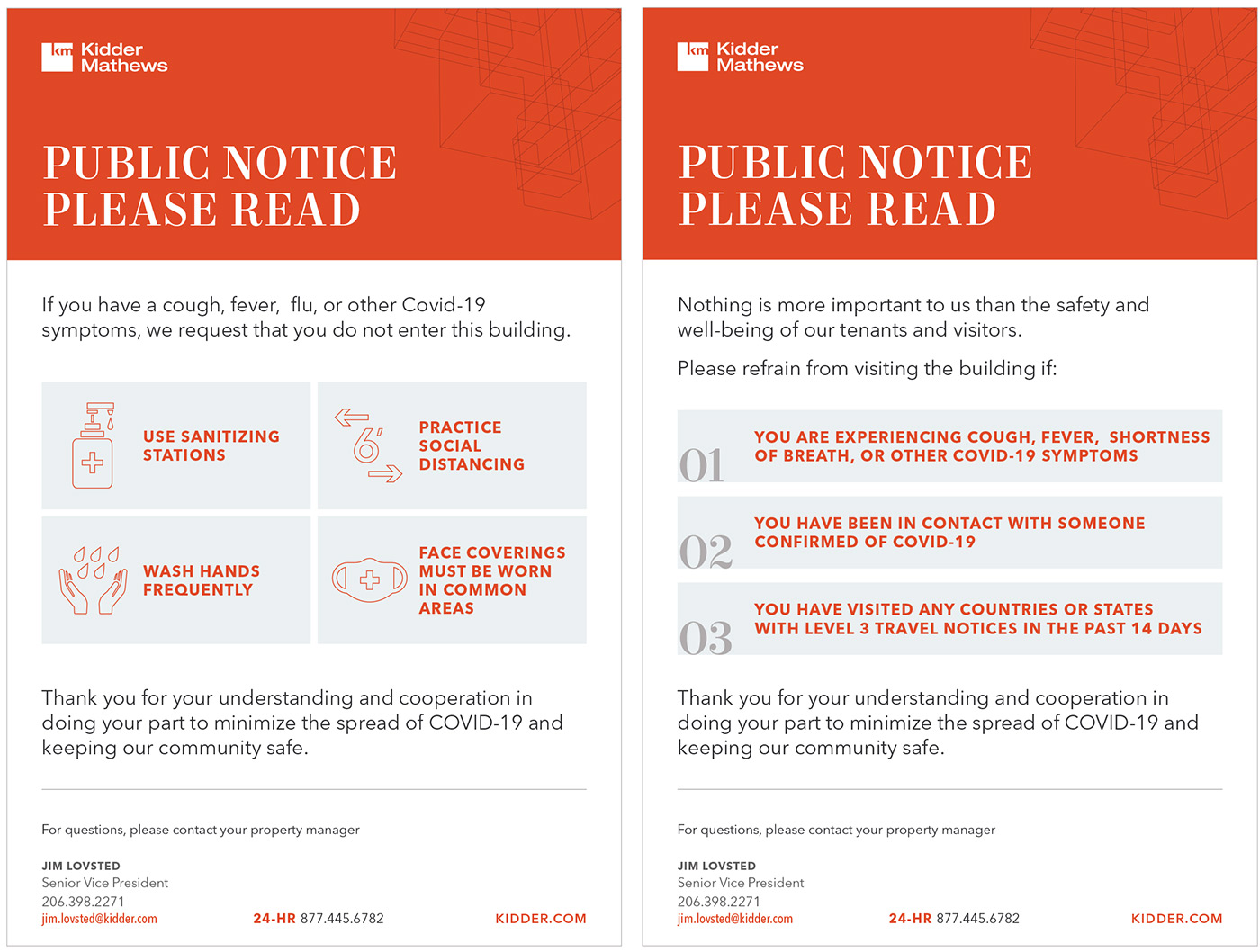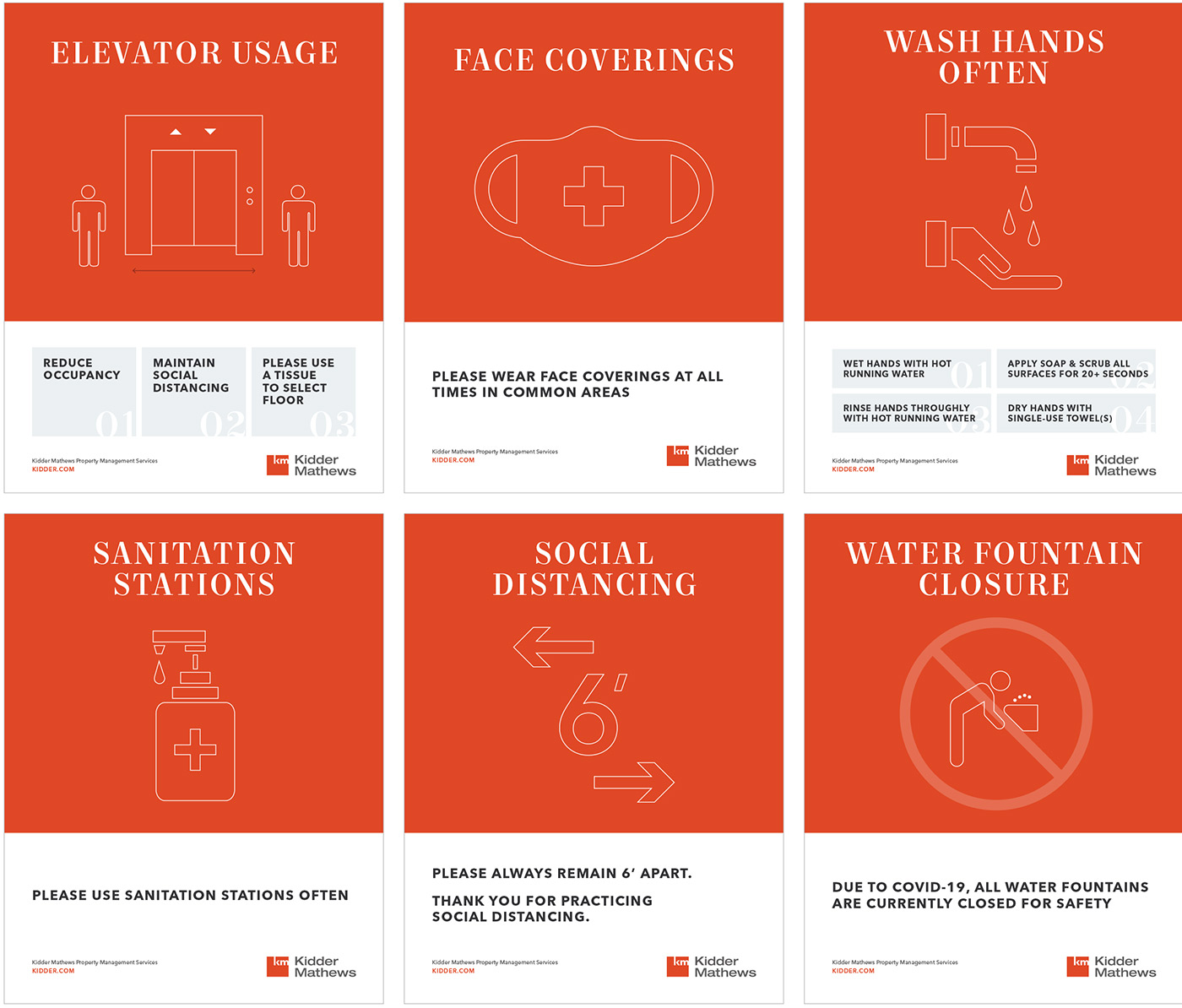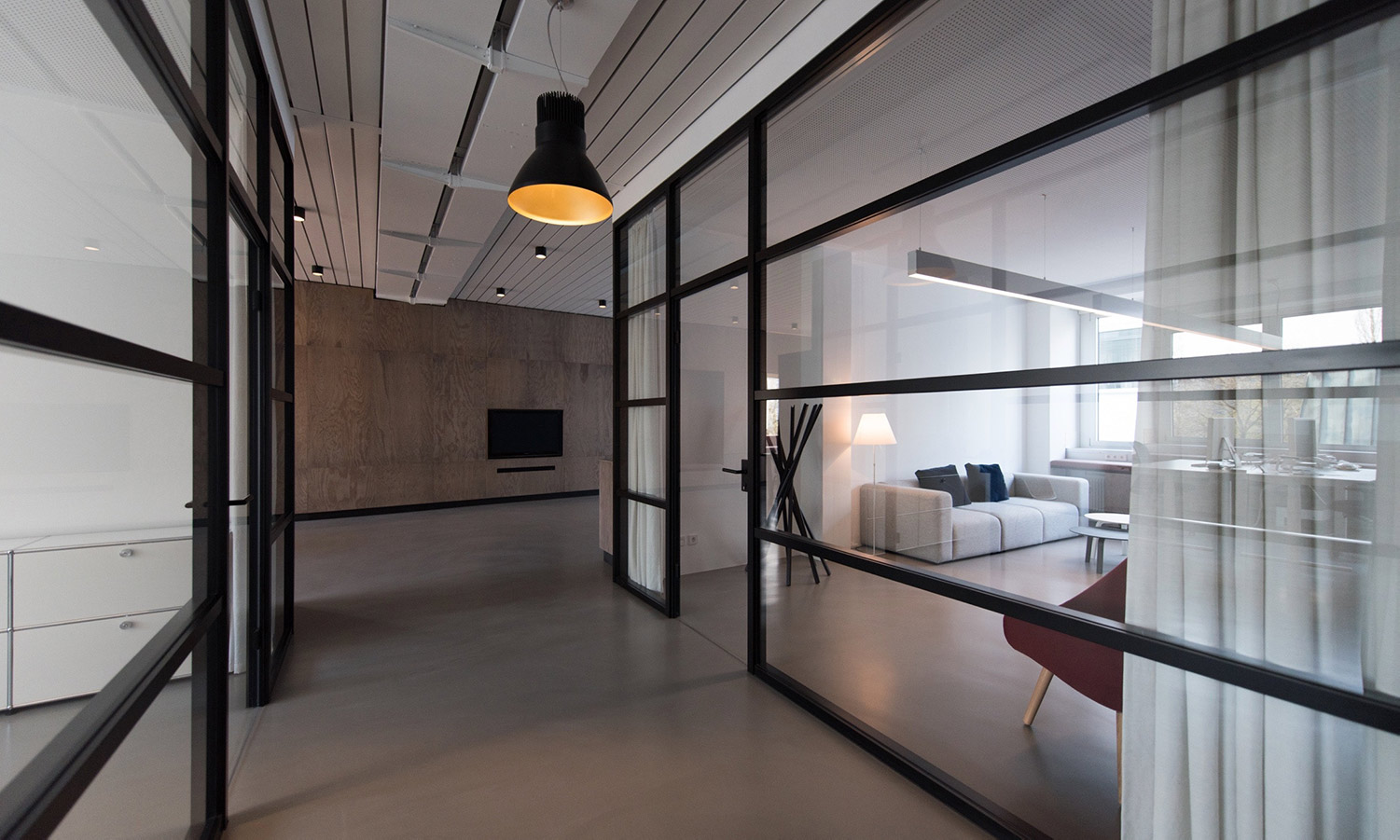The effects of the COVID-19 pandemic have been unprecedented and extraordinary. The Property Management Division of Kidder Mathews has created this document as guidance for the Tenants of the buildings we manage in making informed decisions about re-entering the workspace as quarantine restrictions are eased.
With state and local Stay-at-Home Orders and other various governmental recommendations easing, we anticipate the course for reentry to occur in a phased approach as companies come back to work based on their specific plans and timelines.
All parties must participate for a successful reentry to the building. Therefore, communication between all parties; landlord, tenant and property management is highly critical, taking into consideration the health and safety of each as we re-enter the workplace.
Some tenants have continued to work in the building during the Stay at Home Orders, but most have been working from home. Returning to the building will be different and for many, a cause for anxiety. We wish to reduce that anxiety and share what Kidder Mathews is doing to prepare for your reentry to the building.
To prepare for successful reentry, collaboration and communication is crucial. The health and safety of our tenants, visitors and service providers is our primary concern. You will observe important changes at the building as new protocols have been implemented. Please note that if a building occupant is sick or showing symptoms of COVID-19, they cannot enter the building. Your cooperation is needed to ensure a safe and successful return to the workplace.
This Tenant Guide is broken into three sections:
LANDLORD CONSIDERATIONS
This is what you can expect from the building and Kidder Mathews when your return to work. There are a vast number of critical items and tasks we have taken into consideration to ensure a safe workplace.
TENANT CONSIDERATIONS
These are the items and tasks that each employer / tenant must take into consideration before re-entering the workplace.
ADDENDUM
Specific changes and guidelines for your building.
The content of this Guide is derived from information available from the World Health Organization (WHO), the Centers for Disease Control & Prevention (CDC), the Building Owners and Managers Association (BOMA), the Institute of Real Estate Management (IREM), the American Society of Heating, Refrigerating and Air-Conditioning Engineers (ASHRAE), along with contributions from our vendor partners, and is further informed by the operating experience accumulated from our 70 million square foot, 5 state, management portfolio.
Each state has published minimum requirement to allow businesses to re-open. These include:
THE CAPACITY of the facility to support social distancing and improved and more frequent cleaning.
THE AVAILABILITY of the new and necessary supplies (hand sanitizers, PPE, etc.) and critical support businesses (daycare centers, etc.).
THE AVAILABILITY of widespread testing and monitoring of people with COVID-19 symptoms and ability to isolate and respond to a COVID-19 case on premises.
THE IMPLEMENTATION of regulatory compliant practices.
LANDLORD CONSIDERATIONS
The goal of the Landlord and the Property Management Team is to ensure that your return to the workplace is a smooth and safe process.
BUILDING OPERATIONS
We are reviewing, modifying, adjusting and implementing changes to the building operations.
Below is a list of what we are taking under consideration.
REVIEW access controls, security and camera systems for all common areas and determine if any changes in operations are needed in order to manage ingress/egress, social distancing and safety. This may include lockdown at entry only (not exits) of all but one entry, changes to the building access control hours, special procedures for vendors and visitors, changes in operating hours and potential safety checks.
HVAC SYSTEMS will be assessed to identify opportunities for increasing outside air ventilation rates and filtration efficiency, where possible, in accordance with guidance by CDC, OSHA and ASHRAE. More detail regarding HVAC is provided herein.
PLUMBING SYSTEMS will be evaluated for modifications for increased frequency of hand washing, increased maintenance to ensure proper operations, ample supply of hot water for hand washing and possible retrofit of plumbing fixtures to touchless faucets, urinals, toilets, soap dispensers and paper towel dispensers.
PREVENTIVE maintenance schedules for the engineering teams include frequent flushing of toilets and urinals, running of all faucets and drinking fountains and pouring water into all bathroom drains.
BUILDING LIGHTING SYSTEMS need to be reviewed and possibly adjusted for modified tenant occupancy.
REVIEW layout of furniture in all common areas. Layouts may need to be modified or areas may need to be completely restricted. Some furniture may need to be removed to provide adequate social distancing.
ALL BUILDING automation system (ie. HVAC, lighting etc.) controls and schedules will be evaluated in order to support modified occupancy, revised hours of operation, and desired changes in operations. For the HVAC system, this may include extended hours and increased levels of outside air introduction to the building. For the lighting controls, this may include an increase or decrease in operational hours based on modified tenant work schedules.
ELEVATOR SYSTEM modifications may be required in order to maintain safe social distancing and occupant traffic flow. Furthermore, protocols will be implemented and tenants and visitors will have good visible guidance to these new protocols.
TENANTS who may have suite level security or access control systems may need to be adjusted in order to coordinate with base building systems. In addition, special access may need to be provided for building engineering staff and janitorial crews (non-operating hours access).
ELEVATORS
NEW protocols will be implemented to include maintaining social distancing and safe traffic flow by utilizing building security personnel (if available) and signage to encourage passengers to meet social distancing requirements.
FREQUENT disinfection and cleaning of elevator surfaces including call buttons, handrails and wall panels.
WE WILL PROVIDE (when available) a sanitation station and tissues at the lobby for elevator occupants to use to avoid contact with call buttons, etc.
WE WILL ASSESS any elevator cab HVAC systems and increase ventilation when possible.
IF THERE IS A DISPATCH SYSTEM in the elevator controls, it will be re-programmed where possible in order to support the modified tenant occupancy in the building. Also, where available, automatic call services will be activated.
PROPER SIGNAGE and new protocols will be installed at all elevator cabs to assist with social distancing and safe usage of the elevators. On-site personnel, such as engineers and security staff, will most likely not be available to support this function at all times.
HVAC
INCREASING outside air ventilation rates where mechanically possible.
WHERE POSSIBLE, and in accordance with ASHRAE guidance, enhance central air filtration efficiency over code minimums while ensuring no adverse impacts to HVAC system performance.
EVALUATE running the HVAC system for extended hours as running the system longer enhances the positive impact of increasing outside air ventilation and filtration efficiency.
ASSIST with circulating the increased outside air and ventilation rates, run the toilet exhaust fans continuously when HVAC systems are operating.
NEGATIVE air pressure on construction job sites.
LIMIT HVAC maintenance and non-emergency repairs to non-occupied hours.
IN GENERAL, disabling of heating, ventilating, and air-conditioning systems is not a recommended measure to reduce the transmission of the virus.
GENERAL OPERATIONS & COMMON AREAS
POST SIGNS at the building entry for tenant self-screening. Please note that if a building occupant is sick or showing symptoms of COVID-19, they cannot enter the building.
PROP OPEN doors where possible to minimize contact.
REVIEW building ingress and egress and create order of access to allow occupants to enter / exit at a safe distance while practicing social distancing.
COMPLY with screening protocols as dictated by the CDC and state and local governments. Screenings will be for building staff, property management staff, visitors, vendor-partners and tenants.
REVIEW and potentially modify rules and regulations pertaining to vendor partners and construction activity.
SCHEDULE and coordinate preventative maintenance at various times to reduce occupants in the building and tenant spaces.
REQUIRE tenants, visitors and vendor partners to wear PPE (Personal Protective Equipment) at all times when entering the building and occupying common areas.
REQUEST vendor partners submit their new safety measures and execution as related to COVID-19.
INSTALL touchless technology and equipment, when possible. This could include hands-free trash receptacles, door push / pulls, toe guards and hands-free restroom equipment (faucets, towel dispensers, auto-flushers).
CLEANING ENHANCEMENTS
CREATE schedule of increased cleaning by way of disinfection of key touch points throughout the building to include, but not limited to: entrances, lobbies, common areas, mailboxes, directories, restrooms, all door handles, elevator buttons and handrails.
INSTALL hand sanitizer stations at the entrance(s), restroom(s) and all common areas. Hand sanitizer to be hands-free if possible and contain 60-97% alcohol.
REVIEW potential increased frequency of common area cleaning; additional day porter hours, second day porter, etc.
ENSURE janitorial company is utilizing only EPA approved cleaning supplies and following CDC approved guidelines for cleaning and disposal of PPE.
INQUIRE with each tenant should they require above-standard cleaning for their suite.
ENSURE property is equipped with additional supplies, if and when needed.
GENERAL PRACTICES
PRACTICE social distancing of at least 6 feet from another person at all times.
INSTALLATION of plexi-glass guards at security desks, if applicable.
ESTABLISH occupancy limit for all common areas.
PLACE signage throughout common areas and keep updated as things change.
PROVIDE tenants necessary updates regarding procedures and changes.
REQUIRE tenants to notify Management of any known COVID-19 cases in the building.
SAFETY MEASURES
REVIEW in-place COVID-19 reporting processes and protocols in support of the CDC and state and local directives.
UPDATE building evacuation plans such that gathering places are spread farther apart.
IMPLEMENT and communicate safety procedures for tenants to inform property management of a COVID-19 case or exposure.
BUILDING AMENITIES
FOOD service providers to both common areas and tenant’s suites will need to comply with the building’s new protocols. Consider whether tenants should pick up the food outside the building entrance to limit occupants in the building.
LIMIT occupancy of all common areas (fitness centers, conference rooms, lobby areas, including smoking areas).
REMOVE or reduce seating if necessary.
SCHEDULE increased cleaning of common areas. If opened, fitness centers, bike rooms / lockers, lobbies and conference rooms will require enhanced cleaning and social distancing measures. If unable to accommodate social distancing, consider closing area until further notice.
INSTALL sanitizer stations, cleaning wipes and tissues in all common areas.
REVIEW mail delivery service.
INSTALL signage throughout common area to include various guidelines for social distancing, washing of hands and safety measures.
LIMIT the number of people that can occupy the common areas at one time.
SIGN AND MODIFY smoking areas for social distancing of at least six feet.
REDUCE seating capacity in conference rooms to increase physical distancing.
SIGNAGE EXAMPLES
We have developed a variety of signage templates that may be used at the building. These signs comply with CDC and state and local requirements and are also healthy reminders on how we can keep one another safe when in shared spaces.
11 X 17 SIGNAGE

8 1/2 X 11 SIGNAGE

TENANT CONSIDERATIONS
Tenants of the building have a responsibility to cooperate and implement best practices to safeguard the health and safety of their employees and visitors. As always, be sure to follow the state and local guidelines governing your specific type of business. Continue to support work from home practices and be prepared to adapt to potential reinstatement of Stay at Home Orders as authorities respond to the ever-changing environment surrounding the COVID-19 crisis.
CLEAR AND FREQUENT COMMUNICATION
Recognize that this is an unprecedented and difficult time, and the requirements and recommendations from government and health officials may continue to evolve. Use prominent signage, and clear, continual communications to educate and inform your employees and visitors of the protocols established for your premises and the building. Inform the property manager of your schedule and plan for returning to the workplace so that advance preparations can be made.
OBSERVE BUILDING REQUIREMENTS & PROTOCOLS
Each property is unique in its configuration. Your property manager has inspected the property and has adopted best practices to reduce health and safety risks. Tenants, visitors, and vendor partners must cooperate with the building requirements. Observe signage and follow the protocols implemented at the property.
NOTIFY MANAGER OF ANY CASES OF COVID-19
Communication is the key to keeping our building safe. Immediately notify the property manager of a COVID-19 case so that the other building occupants may be properly notified and appropriate steps can be taken to address exposure concerns in common areas. Observe applicable medical privacy laws, and do not disclose the name or identifying details of affected individuals. Implement proper cleaning for the premises once the COVID-19 case has been removed.
CONTROL ACCESS
Post prominent signage at the entrances of your premises to prohibit entrance to any individuals with symptoms of COVID-19. Enforce the use of a sign-in sheet at entrances. Individuals should affirm that they observed the screening protocols. A sign-in sheet is also an important tool in case individuals subsequently need to be notified of an exposure identified at the premises. Mandate that any sick employees must not enter the premises under any circumstances.
TRAFFIC CONTROL
Take steps to coordinate traffic patterns within the premises. Consider the following recommendations and implement whenever feasible:
DESIGNATE separate entrances and exits and establish single-direction movement paths.
LIMIT interior elevator and stairwell occupancy.
PROP OPEN interior doors where appropriate to limit touch points.
STAGGER shift start and end times, breaks and lunches.
LIMIT the number of occupants in copy rooms.
LIMIT the number of occupants in bathrooms and breakrooms.
REPLACE in-person meetings with virtual meetings.
ARRANGE for no-contact deliveries of office supplies and food.

RECONFIGURE WORKSPACES
Workspaces may be reconfigured to reduce the proximity of employees as they begin to return to the workplace. Reduce the number of cubicles in use, and minimize the amount of furniture in lobbies, conference rooms, and breakrooms to discourage gatherings. Temporarily close amenities within the premises that are likely to encourage congregation.
KNOWING YOUR RESPONSIBILITIES
UNDERSTAND your lease responsibilities pertaining to the building and your demised premises (above standard cleaning, tenant systems, interior premises security, employee access, etc.).
DISCUSS any uncertainties with the property manager. Knowing your areas of responsibility will help assist property management and landlord in a more successful reentry of the building.
FOLLOW your lease provisions pertaining to any premises work that may be required within your space due to alterations needed for social distancing and safer workplace.
ADHERE to any new building rules and regulations provided by the landlord relative space alterations using contractors and sub-contractors and pertaining to working hours and building access.
ENFORCE SOCIAL DISTANCING
Use signage and frequent communication to educate and encourage employees and visitors to your premises to practice social distancing whenever possible. Avoid in-person meetings and abbreviate any in-person meetings that are essential. Refrain from shaking hands. Maintain six feet of distance between individuals. Consider installing a sneeze guard at any reception desk.
HYGIENE & ILLNESS
The best way to prevent illness from COVID-19 is to avoid being exposed to the virus. The virus may be spread by people who do not show symptoms, so all building occupants should practice proper hygiene to help prevent the spread of illness. Wash your hands often with soap and hot water for at least 20 seconds. If soap and water are not available, use a hand sanitizer that contains at least 60% alcohol. Cover all surfaces of your hands and rub them together until they feel dry. Avoid touching your eyes, nose and mouth. Avoid close contact with people. Cover coughs and sneezes with a tissue and through used tissues in the trash. Above all, individuals who are sick or have been exposed to the virus should stay away from the building until cleared to return.
PERSONAL PROTECTION & SANITATION
The use of personal protection and frequent and thorough sanitation can help minimize exposure risk within your premises. Provide appropriate personal protection equipment to your employees and ensure that they are trained on the correct use and appropriate disposal methods for personal protection equipment. Distribute face coverings for wear in common interior areas. Obtain and make available alcohol-based (60-97%) hand sanitizer and surface wipes. Anticipate the needs of your employees, and order early to compensate for stock shortages and delivery delays. Establish a routine of wiping down high touch interior surfaces frequently thoroughly throughout the workday including tables, doorknobs, light switches, counter tops and handles. Employees should also periodically wipe down their personal workspace areas and equipment during the workday including desks, phones and keyboards. Maintain a clean desk policy; this will permit the janitorial crew to also clean the desk.
It is our sincere desire that all occupants of the building remain safe and healthy. We appreciate your cooperation to ensure a successful return to the workplace. Please do not hesitate to contact your property manager if you have questions about returning to the building.
